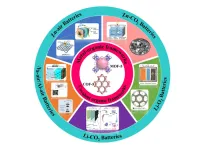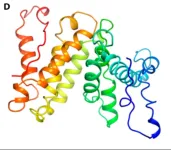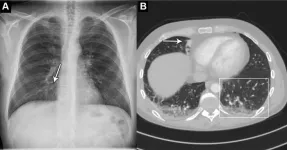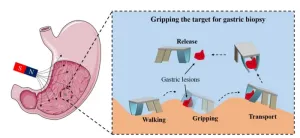(Press-News.org) A United States Food and Drug Administration mandate to limit the dosage of acetaminophen in pills that combine acetaminophen and opioid medications is significantly associated with subsequent reductions in serious liver injury, according to a study led by investigators at the University of Alabama and Weill Cornell Medicine. The federal mandate was announced in 2011 and implemented in 2014. The results were reported March 7 in the medical journal JAMA.
“After researchers found that more than 40 percent of acetaminophen-induced acute liver failure cases involved combination acetaminophen and opioid medications, and an FDA advisory panel recommended more stringent safety measures be enacted, the FDA mandated a limit on the dosage of acetaminophen in these drugs,” said Dr. Babak Orandi, a visiting assistant professor of surgery at the UAB Heersink School of Medicine, an Obesity Medicine fellow and instructor in medicine at Weill Cornell Medicine, and an assistant attending physician at NewYork-Presbyterian/Weill Cornell Medical Center. “Given the significant risk of acute liver failure, it was critical to determine if the mandate was having the desired effect."
“The FDA mandate that limits acetaminophen dosage to 325 milligrams per tablet in combination acetaminophen-opioid medications was associated with a significant and persistent decline in the yearly rate of hospitalizations and proportion per year of acute liver failure cases involving acetaminophen and opioid toxicity,” said study leader and University of Alabama at Birmingham surgeon-scientist Dr. Jayme Locke. At UAB, Dr. Locke directs the Comprehensive Transplant Institute in the Marnix E. Heersink School of Medicine.
Patient safety — while still providing pain relief — is the reason to combine different analgesic classes in a medication. Together, the multiple drugs should provide additive analgesia while minimizing toxicity by using lower doses of each component.
The challenge was that too-high doses of acetaminophen, also known as paracetamol, are toxic to the liver. By 2005, one study found that 43 percent of acetaminophen-induced acute liver failure cases involved combination acetaminophen-opioid medications. So, an FDA advisory panel in 2009 recommended prohibiting the sale of the combination acetaminophen-opioid medications, though the FDA instead acted to limit the dose of acetaminophen in those combination acetaminophen-opioid medications to 325 milligrams. Before the FDA mandate, such medications contained 325 to 750 milligrams of acetaminophen.
To examine the effect of this change, researchers in the JAMA study looked at yearly rates of hospitalization and acute liver failure cases in two independent, contemporaneous data sources, the National Inpatient Sample, or NIS, and the Acute Liver Failure Study Group, or ALFSG. The NIS is a very large U.S. hospitalization database with more than 473 million hospitalizations from 2007 to 2019. The ALFSG is a prospective, 32 U.S. medical-center cohort of adult patients with acute liver failure from 1998 to 2019.
In each data source, Drs. Orandi, Locke and colleagues found similar declines in the yearly rates of hospitalization and acute liver failure cases associated with acetaminophen-opioid medications after the mandate. They also compared toxicity seen from acetaminophen-opioid medications versus toxicity from acetaminophen alone. In contrast to the declines from acetaminophen-opioid medications after the mandate, rates of hospitalization and acute liver failure cases associated with acetaminophen alone — where the dosage is not constrained by the FDA mandate — continued to rise after the combination drug mandate.
The detailed results looked at four groups: NIS acetaminophen-opioid toxicity, NIS acetaminophen-alone toxicity, ALFSG acetaminophen-opioid toxicity and ALFSG acetaminophen-alone toxicity. Three different time frame analyses were done for each group: 1) before and after the FDA announcement date in 2011, 2) before and after the FDA implementation date in 2014, and 3) a washout comparison of cases before the 2011 announcement date and after the 2013 implementation date.
As an example of detailed findings, in the NIS group, the predicted incidence of hospitalizations associated with acetaminophen-opioid toxicity one day prior to the FDA announcement was 12.2 cases per 100,000 hospitalizations. By Q4 2019, it was 4.4 cases per 100,000 hospitalizations. The odds of a hospitalization involving acetaminophen-opioid toxicity increased 11 percent per year before the announcement and decreased 11 percent per year after the announcement.
In the ALFSG group, the predicted percentage of acute liver failure cases from acetaminophen-opioid toxicity one day prior to the FDA announcement was 27.4 percent. By Q3 2019, it was 5.3 percent. The percentage of acute liver failure cases involving acetaminophen-opioid toxicity increased 7 percent per year before the announcement and decreased 16 percent a year after the announcement.
The NIS database included 39,606 cases of hospitalizations involving acetaminophen-opioid toxicity, and the ALFSG database had 2,631 patients hospitalized with acute liver failure, including 465 with acetaminophen-opioid toxicity.
The authors caution that the study shows association, not causality. The changes in hospitalizations could have also come from increased public awareness and stiffer label warnings required by the FDA as part of the mandate, or changes in clinician prescribing patterns. However, in Canada, changes in labeling without an accompanying limit in the acetaminophen dosage was not associated with a decline in hospitalizations.
Dr. Locke is a professor in the UAB Department of Surgery, chief of the Division of Transplantation, and she holds the Arnold G. Diethelm Endowed Chair in Transplantation Surgery.
Co-authors with Locke and Orandi are M. Chandler McLeod and Paul A. MacLennan, UAB Department of Surgery; William M. Lee, University of Texas Southwestern Medical Center, Dallas; Robert J. Fontana, University of Michigan Medical School, Ann Arbor; Constantine J. Karvellas, University of Alberta School of Medicine, Edmonton, Canada; Brendan M. McGuire, UAB Department of Medicine, Division of Gastroenterology and Hepatology; Cora E. Lewis, UAB School of Public Health, Department of Epidemiology; and Norah M. Terrault, University of Southern California Keck School of Medicine, Los Angeles.
Support came from National Institutes of Health grant DK58369, National Center for Advancing Translational Sciences grant TR003097, and a Society for Surgery of the Alimentary Tract Career Development Award.
The original version of this story appears on the UAB newsroom.
END
FDA rule lowering drug dose is associated with less liver injury
Mandate limiting acetaminophen in drug combinations with opioids appears effective
2023-03-07
ELSE PRESS RELEASES FROM THIS DATE:
Counting heads: how deep learning can simplify tedious agricultural tasks
2023-03-07
The selective breeding of grain crops is one of the main reasons why domesticated plants produce such excellent yields. Selecting the best candidates for breeding is, however, a remarkably complex task. On one hand, it requires a skilled breeder with trained eyes to assess plant resistance to disease and pests, crop growth, and other factors. On the other hand, it also requires precise tool-assisted measurements such as grain size, mass, and quality.
Although all these standard measures are useful, none of them takes into account the number ...
Evidence for the health benefits of consuming more live microbes
2023-03-07
Safe live microorganisms are found in a variety of foods we eat every day, from yogurt and other fermented foods, to raw fruits and vegetables. Despite the widespread idea that these mixtures of live microbes contribute to health, convincing evidence linking live dietary microbes to health benefits has been lacking.
A new study provides some of the first real-world evidence that higher consumption of live microbes may promote health. A group of scientists led by the International Scientific Association for Probiotics and Prebiotics (ISAPP) classified over 9,000 individual ...
IVI launches global study to determine the burden of HPV among girls and women
2023-03-07
The International Vaccine Institute (IVI), an international organization with a mission to discover, develop, and deliver safe, effective, and affordable vaccines for global health, announced the start of a multi-country study to better understand the burden of Human papillomavirus (HPV) among girls and women in low- and lower middle-income countries. This study received $14.99 million USD in funding from the Bill & Melinda Gates Foundation with $1 million USD co-funding from the Swedish government and will help inform intervention implementation and prioritization of research and development efforts that have the greatest potential public health ...
Novel porous materials are ideal for metal-air batteries, researchers report
2023-03-07
Sustainable energy solutions cannot be pulled out of thin air. However, combining air with metal and other frameworks may pave the way for environmentally friendly energy conversion and storage, according to a research team based in China.
They published their review of novel porous materials — called metal-organic frameworks (MOFs) and covalent organic frameworks (COFs) — and their potential to advance metal-air batteries on 03 March in Nano Research Energy.
The porous crystal material frameworks comprise various arrangements of bonded materials that can induce desired properties, including the ability to accelerate reactions between oxygen and metals ...
Novel biomimetic polypeptides activate tumor-infiltrating macrophages, offering hope for cancer therapy
2023-03-07
Macrophages are highly specialized cells of the immune system that help the body detect and fight deadly pathogens. In particular, M1-like macrophages detect and destroy tumor cells, and release protective chemokines such as interleukin (IL)-6 and tumor-necrosis factor α (TNF α), thus shielding the body from life-threatening pathologies like cancer. However, not all macrophages show anti-tumor potential. Certain types of macrophages, i.e., M2-like macrophages, promote tumor growth. Luckily, the desired macrophage phenotype—a set of traits resulting from the genetic makeup of the macrophage—can be activated by modulating the ...
AI accurately identifies normal and abnormal chest x-rays
2023-03-07
OAK BROOK, Ill. – An artificial intelligence (AI) tool can accurately identify normal and abnormal chest X-rays in a clinical setting, according to a study published in Radiology, a journal of the Radiological Society of North America (RSNA).
Chest X-rays are used to diagnose a wide variety of conditions to do with the heart and lungs. An abnormal chest X-ray can be an indication of a range of conditions, including cancer and chronic lung diseases.
An AI tool that can accurately differentiate between normal and abnormal chest X-rays would greatly alleviate the heavy workload experienced by radiologists globally.
“There is an exponentially growing demand for medical ...
Study: intraoperative 3-D imaging can improve accuracy of pedicle screw placement in spine surgery
2023-03-07
A study at Hospital for Special Surgery (HSS) found that intraoperative three-dimensional (3D) imaging was superior to two-dimensional radiographs in confirming the accuracy of pedicle screw placement during spine surgery. The research was presented today at the American Academy of Orthopaedic Surgeons (AAOS) Annual Meeting in Las Vegas.
Many spinal surgeries require the use of implants called pedicle screws to stabilize the spine. Precise positioning of these screws is critical for a successful outcome. “Two-dimensional biplanar radiographs [BPR] ...
Magnetically actuated quadruped soft microrobot toward gastric biopsy
2023-03-07
Recently, a research team from Shenzhen Institute of Advanced Technology, Chinese Academy of Sciences, proposed a bionic quadruped soft thin-film microrobot actuated by magnetic fields with a mass of only 41 mg, which promises to be applied to stomach examination and treatment. Researchers realized the multimodal locomotion control of the soft microrobot in magnetic fields and the grasping and transportation of micro-objects by the soft microrobot.
The new paper, published in Cyborg and Bionic System, details the process ...
Scientists observe “quasiparticles” in classical systems for the first time
2023-03-07
Starting with the emergence of quantum mechanics, the world of physics has been divided between classical and quantum physics. Classical physics deals with the motions of objects we typically see every day in the macroscopic world, while quantum physics explains the exotic behaviors of elementary particles in the microscopic world.
Many solids or liquids are composed of particles interacting with one another at close distances, which sometimes results in the rise of “quasiparticles.” Quasiparticles are long-lived excitations that behave effectively as weakly interacting particles. The idea of quasiparticles was introduced by the Soviet physicist Lev Landau in 1941, and ...
Slicing capacity-centered mode selection and resource optimization for network-assisted full-duplex cell-free distributed massive MIMO systems
2023-03-07
Network-assisted full-duplex (NAFD) systems enable uplink and downlink communications within the same time-frequency resources, so as to avoid the overhead of switching uplink/downlink modes. However, as the number of users and access points (APs) proliferated, mass access brings significant overhead in mode selection. In addition, the differentiated service demands among users also makes the effective utilization of resources difficult. Combined with network slicing technology, a slicing capacity-centered mode selection and resource optimization scheme is proposed. This scheme adopts a double-layer deep reinforcement ...
LAST 30 PRESS RELEASES:
Making lighter work of calculating fluid and heat flow
Normalizing blood sugar can halve heart attack risk
Lowering blood sugar cuts heart attack risk in people with prediabetes
Study links genetic variants to risk of blinding eye disease in premature infants
Non-opioid ‘pain sponge’ therapy halts cartilage degeneration and relieves chronic pain
AI can pick up cultural values by mimicking how kids learn
China’s ecological redlines offer fast track to 30 x 30 global conservation goal
Invisible indoor threats: emerging household contaminants and their growing risks to human health
Adding antibody treatment to chemo boosts outcomes for children with rare cancer
Germline pathogenic variants among women without a history of breast cancer
Tanning beds triple melanoma risk, potentially causing broad DNA damage
Unique bond identified as key to viral infection speed
Indoor tanning makes youthful skin much older on a genetic level
Mouse model sheds new light on the causes and potential solutions to human GI problems linked to muscular dystrophy
The Journal of Nuclear Medicine ahead-of-print tip sheet: December 12, 2025
Smarter tools for peering into the microscopic world
Applications open for funding to conduct research in the Kinsey Institute archives
Global measure underestimates the severity of food insecurity
Child survivors of critical illness are missing out on timely follow up care
Risk-based vs annual breast cancer screening / the WISDOM randomized clinical trial
University of Toronto launches Electric Vehicle Innovation Ontario to accelerate advanced EV technologies and build Canada’s innovation advantage
Early relapse predicts poor outcomes in aggressive blood cancer
American College of Lifestyle Medicine applauds two CMS models aligned with lifestyle medicine practice and reimbursement
Clinical trial finds cannabis use not a barrier to quitting nicotine vaping
Supplemental nutrition assistance program policies and food insecurity
Switching immune cells to “night mode” could limit damage after a heart attack, study suggests
URI-based Global RIghts Project report spotlights continued troubling trends in worldwide inhumane treatment
Neutrophils are less aggressive at night, explaining why nighttime heart attacks cause less damage than daytime events
Menopausal hormone therapy may not pose breast cancer risk for women with BRCA mutations
Mobile health tool may improve quality of life for adolescent and young adult breast cancer survivors
[Press-News.org] FDA rule lowering drug dose is associated with less liver injuryMandate limiting acetaminophen in drug combinations with opioids appears effective





